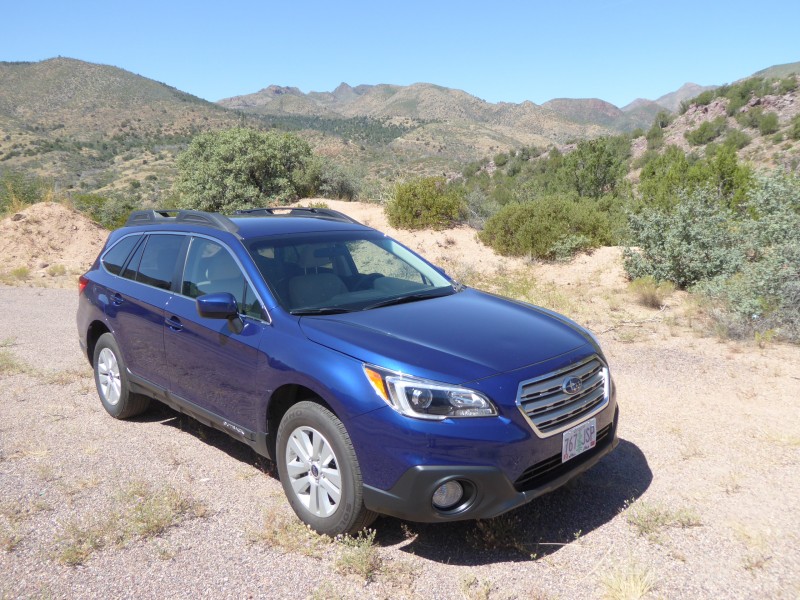

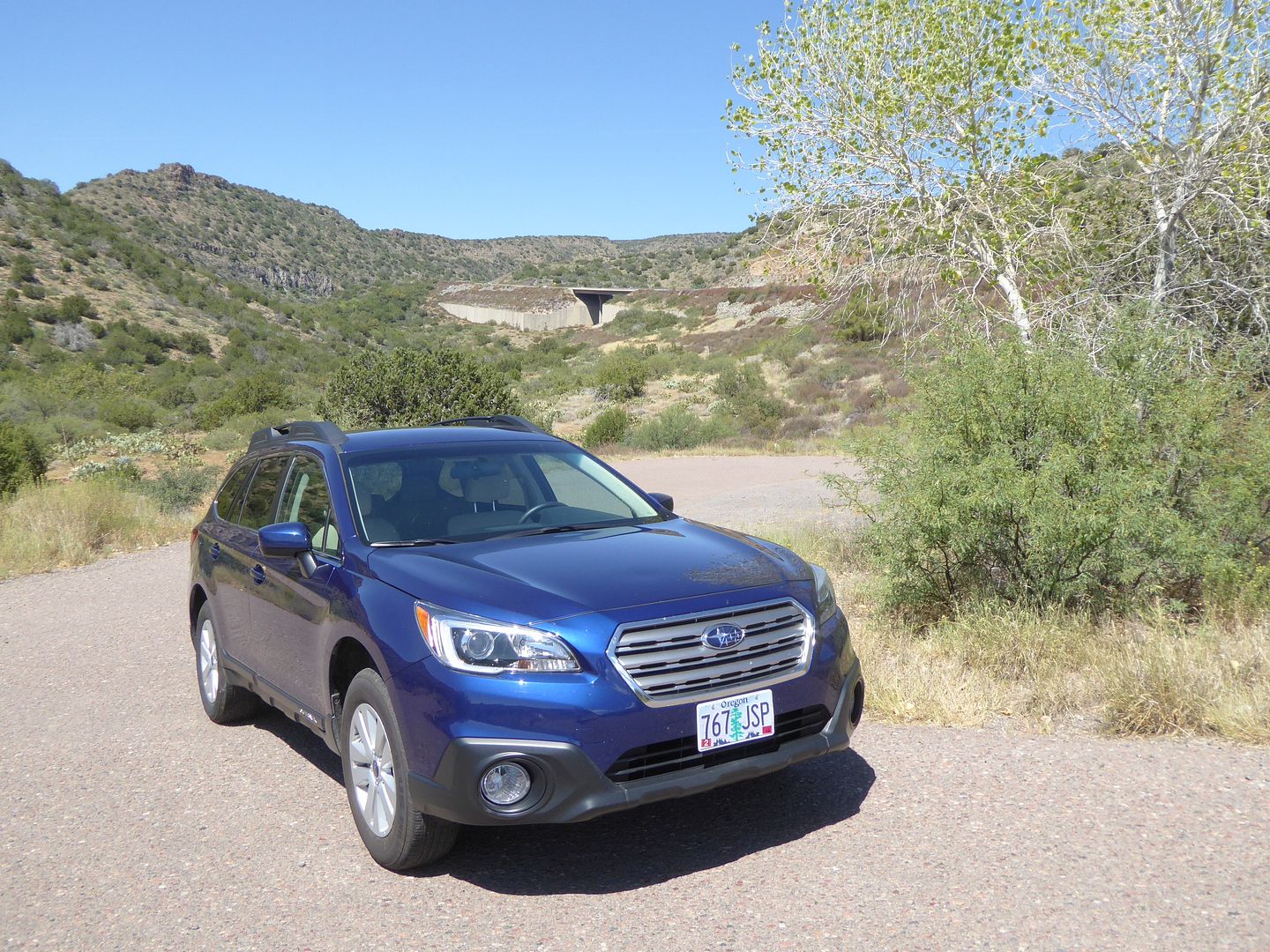





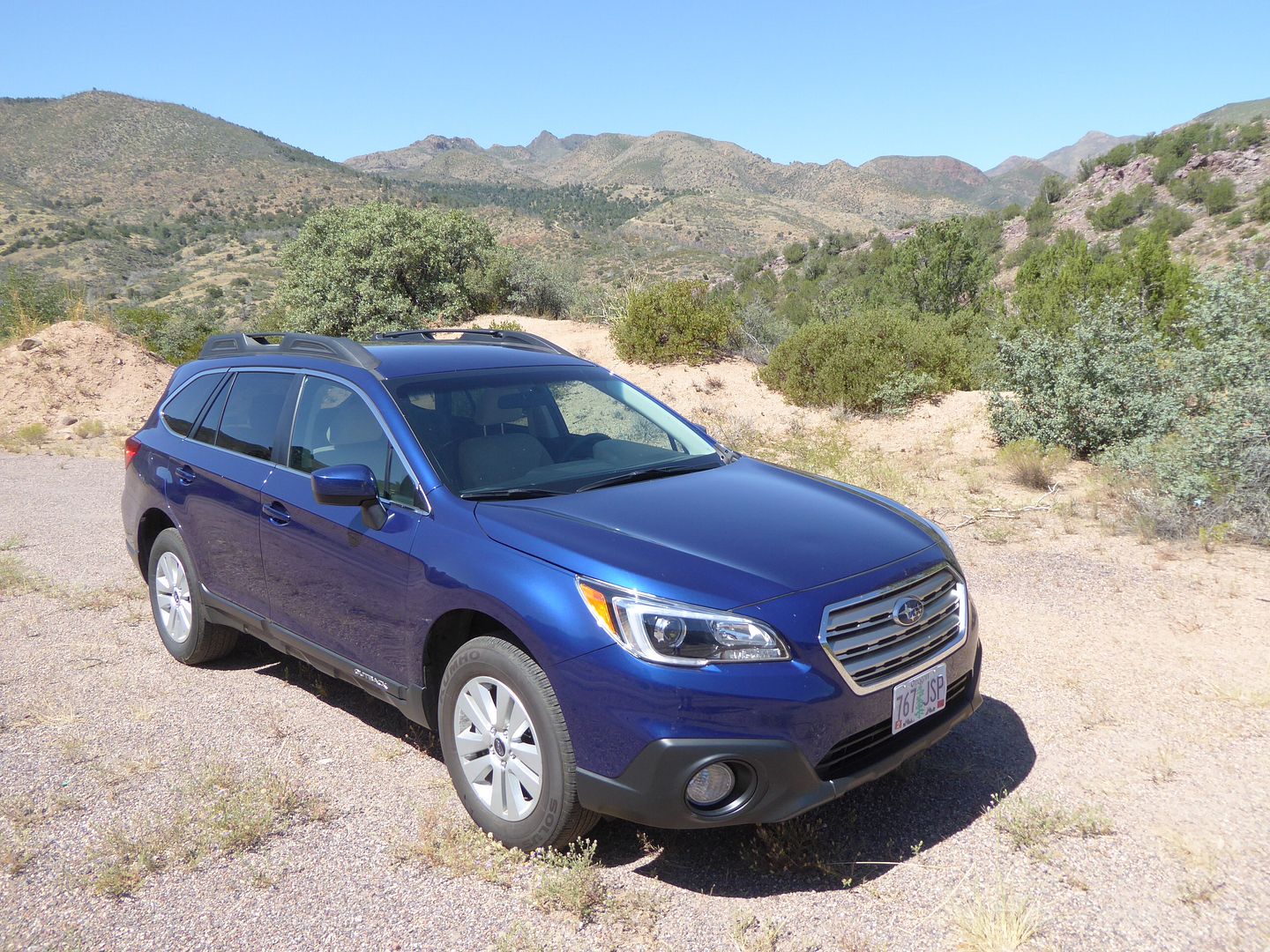









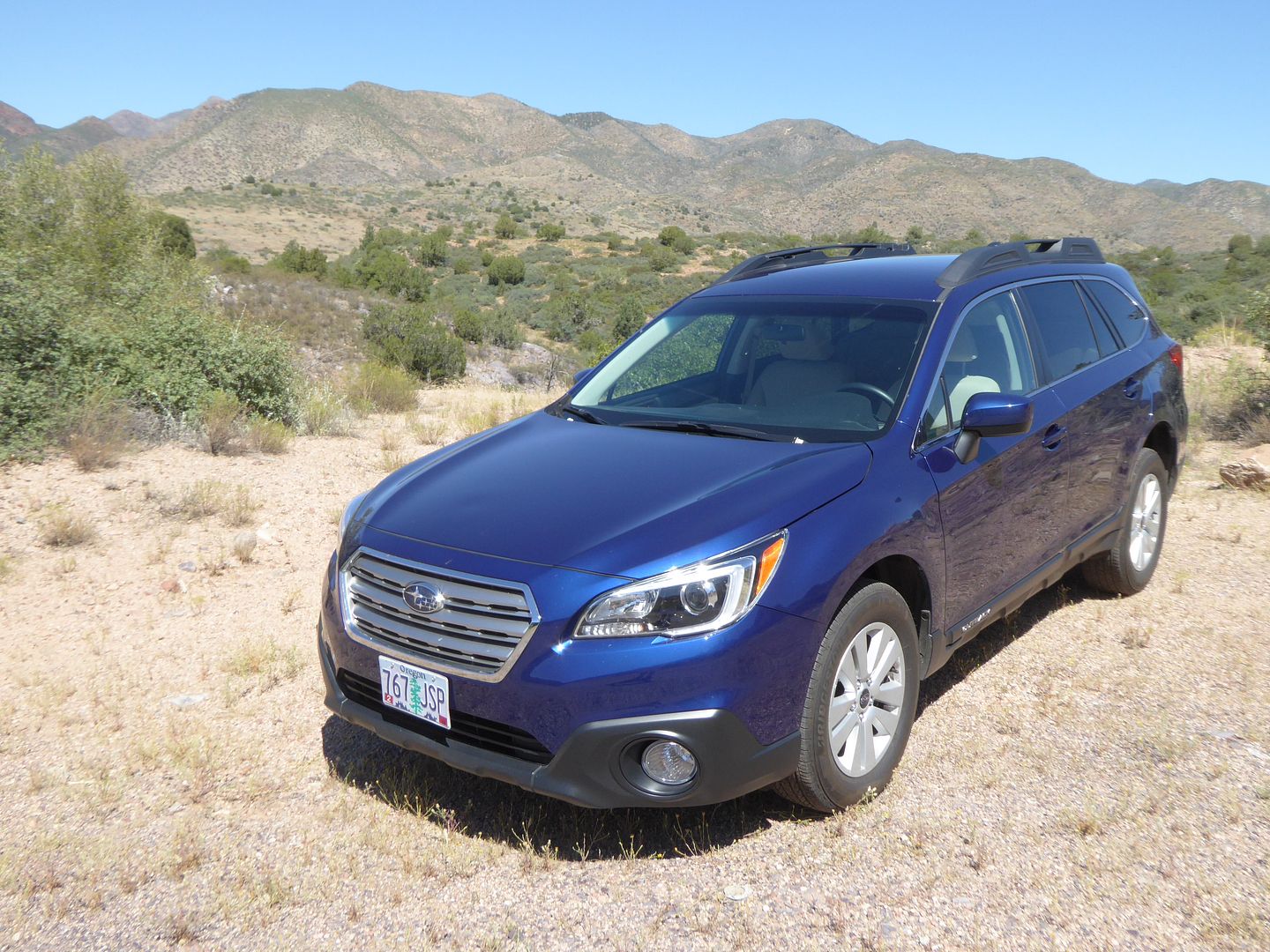












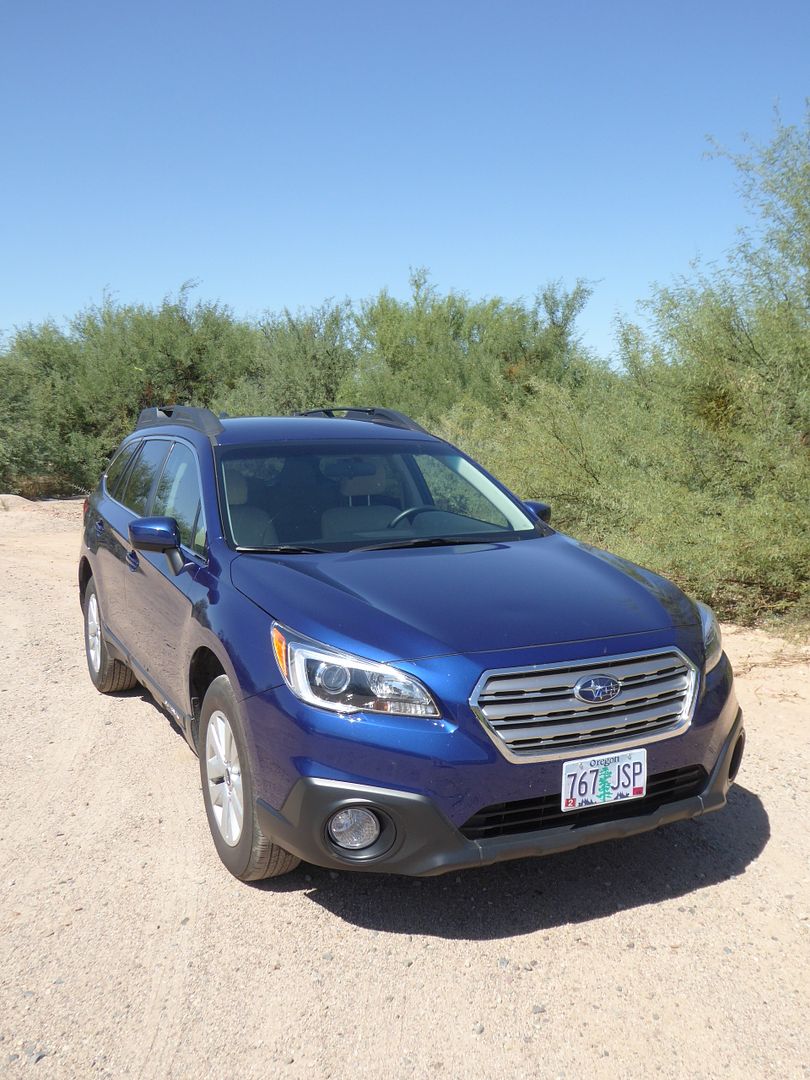





















You don’t see recent Subaru models on UK roads very often, and the chances of getting to drive one are accordingly quite slim, but in America, that is not the case. As large car rental companies carry models from almost every brand that is on the market, you would have thought that sourcing one in the US should not be that hard. But, certainly in the Pacific South West, it is. For the past few years, there have been very few Subaru models in the fleets of Hertz (and, I gather Avis and National are equally lacking in them), and on the odd occasion that they do appear, they are always quickly snapped up. My chance to get behind the wheel of one came on arriving in Phoenix, well after the evening busy period, when I spotted the latest Outback model parked up in the area which under their new Ultimate Choice rules means I could simply get in it and drive it away. I noted that it bore Oregon plates, so not a local car, but this does not matter. The fact that it was in a rather bold blue colour, which Subaru call Lapis Blue Pearl, was an added bonus, as this would make quite a change from a sea of white, silver and grey rental cars.
Subaru have used the Outback name since 1995 when it was applied to the second generation Legacy Estate, and was properly titled Legacy Outback. Principal differences were the lower body cladding and raised ground clearance. Successive generations of the Legacy have included an Outback variant, and gradually, market by market, the name Legacy has been dropped, meaning that outside Japan, the last two versions of the car have been known simply as the Subaru Outback. The latest model was launched at the 2014 Chicago Auto Show, along with the Legacy Sedan, and went into production for the 2015 model year, reaching US dealers at the very end of 2014. The sixth generation Legacy and Outback presented a careful evolution of the successful (in the US), fifth generation car, with styling that was closely related, but a little more cohesive looking, an upgraded interior, extra safety features and the addition of the latest in infotainment set ups. The Outback (but not the Legacy) reached European markets in the first half of 2015, but has remained a rare sighting, with only a few hundred being sold each year, whereas in America both models have continued to find additional favour each year. The Outback is now the best-selling Wagon (Estate) in America.
As with the previous model, US market Outbacks are offered with a choice of two engines: a 2.5 litre flat 4, developing 175 bhp and 174 lb-ft of torque and a more potent 3.6 litre horizontally opposed 6 putting out 256 bhp. The test car had the smaller engine. It is coupled to a standard continuously variable gearbox. It also came with the PZEV certification. PZEV stands for Partial Zero Emissions Vehicle, and I’ve seen this on all rental Subaru models I’ve had (not many, it has to be admitted!) over the past few years. The first time I came across it, I was intrigued, so had to do some research to find out more. I have to confess that I was intrigued by PZEV, so I looked it up. To my mind, Zero is Zero, so I wondered how it could be Partially Zero. Subaru’s explanation is as follows: the catalytic converter features a finer honeycomb mesh to more effectively convert exhaust gases by neutralising them through a chemical reaction. A charcoal filter in line with the engine air filter absorbs fuel and oil vapours that normally escape into the atmosphere when a typical engine is turned off. Special fuel injectors also reduce evaporative emissions when the car is at rest. The ignition timing is automatically adjusted on start-up to heat the catalytic converter more quickly and ensure that the emissions controls are working at peak efficiency at all times. The explanation that I sourced on the web goes onto to say that this can mean a rather unusual noise when you start the Legacy PZEV up. Well, with a flat four Subaru, unusual noise is what you expect, and probably rather revel in. The first time I fired it, I did get a bit of a surprise, but after that, the traditional Subaru boxer-engined noise seemed rather too muted to be particularly distinctive. The net of this is that the PZEV is apparently the cleanest running petrol engine car in the USA, with zero evaporative emissions and meeting California’s SULEV (Super Ultra Low Vehicle Emissions) standard, making it 90% cleaner from an emissions point of view than other cars. It is an interesting idea that what matters is the complete emissions not just the CO2 which has become the sole focus of manufacturers who sell in the EU markets. There is no different in power output compared to the non-PZEV cars, and Subaru claim that maintenance costs are no higher. Clever.
Just as with the previous car, I found that the distinctive sound of a Subaru engine is not completely banished, just muted somewhat. Get to around 3000 rpm, and your ears will tell you that this is that bit different from your ordinary 4 cylinder. 175 bhp is around the class average for saloon cars of this size, but the Outback has the extra weight of the estate body and the all-wheel drive system, so it means that the car is not exactly quick. It is OK, though, and provided you are happy to work the engine hard – and you probably will be, as then you get that distinctive Subaru sound – it will cope with even the steeper inclines on my test route out of Phoenix heading up towards Payson. It is generally smooth and refined, with low noise levels when cruising at a steady speed. I drove the Outback for most of the test mileage and the fuel needle did not move, remaining well above the Full mark. Clearly this was a rental car that did actually have a genuinely full tank. It did drop, though, and by the time I was due to return it, I needed to put 6.15 gallons in, which, having covered 159 miles, computes to 25.85 mpg US or 30.88 mpg Imperial, a decent enough figure.
The flat four engine does sit lower in the car than a conventional in-line unit, as a glance under the bonnet will evidence, when you are presented with a rather unfamiliar looking sight. In the case of the Outback, though, that does not translate to something with really sporty handling. In fact, there is some understeer present at moderate speeds on the swoopier bends of the test route. The steering is precise, with good weighting and feel to it, and you would have to be doing something pretty reckless to get yourself in trouble with this car, as grip is also good. I did not take it off-road – well, not more than a few yards at various photography locations – but the Outback is designed so that you can. The ride height is raised a little, with ground clearance of a generous 8.7″ and there is some protection underneath. There are settings for off-road and towing that you can set from within the car. Of more interest to the driver and passengers will be how it rides on tarmac, and the answer is that it seemed pretty good. Arizona’s roads are generally well-maintained and smooth, so this was not as arduous a test as it would have in the next State to the west. Some of this must be down to what by modern standards are very high profile tyres, as these were 235/65 R17s. There were no issues with the brakes. An electronic parking brake is fitted, and is operated by a button in the centre console. With plenty of glass and a good field of vision from the door mirrors, visibility was fine. A rear-view camera was fitted, and this projects a good quality image onto the infotainment screen.
I made the comment in my test of the previous generation Outback that the interior was the best I had come across in a Subaru, and this one is a notable step-up again. From being pretty much at the bottom of the class, the firm is now producing something that is now pretty decent. A mixture of materials and textures feature. Leather is only used to wrap the steering wheel and on the armrests. Good quality plastics, that are soft to the touch are used for the main dash moulding, black in the case of the test car, with an inlay across the car of a sort of milled aluminium effect, with a graphite inlay used around the gear lever area. The upholstery was a sort of oatmeal colour, with a box velvet type material used for the central section of the seats, and some of this was also used on the door casings. The fit and finish were good. Couple this with a neat and integrated design to the dashboard and the whole effect is good. A curved binnacle houses the instruments. There are two large ones, with smaller gauges for water temperature and fuel level set within them. There is a blue outer ring to the rev counter and speedometer which was particularly prominent (and quite attractive) at night. Between the dials is a digital display area. As with the previous model, the top of this area contains a digital bar chart, with coloured bars to the right in green and to the left in amber, which reflect an interpretation of your current fuel economy. There is a digital repeater for the speedo and below this the mileometer reading. The centre of the dash contains the touch sensitive display screen for what Subaru call StarLink. Like many current systems this now incorporates most of the audio unit functions, with just an on/off and volume knob, but also – thankfully – one to tune the frequencies also present. Other functions available include phone and Bluetooth integration, and a series of Apps, which include weather forecast and local fuel price search, though when I tried to investigate these, it turned out they were dependent on the SXM subscription, which also covers the XM Satellite radio, and this had expired (the car was about 7 months old). Below this are the buttons for the dual-zone climate control, which proved effective in offsetting the 100 degree heat of the test day. Twin column stalks operate indicators, lights and wipers, and there are plenty of buttons on the steering wheel boss for audio repeater and cruise control. Two buttons in the centre console are for off-road and tow modes, and there is also the electronic handbrake here.
There’s electric adjustment for the driver’s seat in this version of the Outback, with three buttons mounted on the outside side of the seat, so it was easy to get the optimum driving position, and the steering wheel – manually adjusted – telescopes in and out as well as up and down. I did not spend long periods of time driving this car, but all the indications are that you would not suffer were you to do so, as the seat seemed very comfortable, with support in all the right places. The front passenger will have to adjust their seat manually, but gets the same range of options including a height adjuster. Space in the rear of the Outback is generous. There’s lots of leg room, even with the front seats set quite well back, and headroom will not be an issue either. You can alter the angle of the rear seat backrest through a fairly small range, for those who want to recline it somewhat. There is a drop down central armrest with cup holders in its upper surface.
The boot is a good size, too. A nice regular shape, there are lots of hooks on the side panels so you could anchor things down if you needed to. The rear seats are split 40/20/40 and the backrests simply drop down to create a flat and long load platform. There are release levers mounted on the side trim by the tailgate to do this, as well as using those on the backrest itself. I was pleased to see that although the seat belt for the middle seat occupant is mounted on the roof, it does recall all the way when not in use, so, unlike a lot of cars, this will not cut across the load bay. There is a small amount of space under the boot floor for odds and ends. Of course, if this is not enough, then you can exploit the fact that there are standard and chunky looking roof rails fitted as standard. Inside the cabin, there is a reasonable sized glove box, there are bins on all four doors, moulded to take a bottle, and there is a deep cubby under the central armrest with a movable top tray in it, and as well as a small lidded area over the driver’s left knee, there is a large lidded cubby in front of the gearlever, which also contains the USB and AUX ports. For those in the rear, there are map pockets on both front seat backs, and a small recess in the back of the central console armrest unit.
The base Outback 2.5i starts at $25,645, which is relatively cheap for the class. Standard features include symmetrical all-wheel drive, Halogen projector low-beam headlamps with Halogen multi-reflector high-beams, fog lights, cloth seating, a four-speaker sound system, a rearview camera, HD Radio, a USB port, satellite radio, Bluetooth, and the StarLink infotainment system with a 6.2″ touch screen and smartphone integration. There are no option packages for this trim. The Outback Premium trim, like the test car, begins at $27,695 and is only available with the four-cylinder engine. Upgraded features of this trim include a 10-way power driver’s seat, heated front seats, two USB ports, a six-speaker audio system, a 7″ touch-screen infotainment display, and dual-zone climate control. For $1,695, you can purchase a package that includes a power-operated tailgate and a moonroof. A $1,995 package with the Subaru EyeSight safety technology suite includes adaptive cruise control, automatic braking, lane departure warning, lane keep assist, blind spot monitoring, rear cross traffic alert, high beam assist, and a power tailgate. For $3,590, you’ll get the moonroof, power tailgate, and all the safety features, as well as a navigation system. The Outback Limited trim starts at $32,390 with the four-cylinder engine and $34,995 with the six-cylinder engine (3.6R Limited). Standard features at this level include leather seating, heated rear seats, keyless entry, push-button start, a power tailgate, a Harman Kardon speaker system, blind spot monitoring, rear cross traffic alert, and a rearview camera. The only option package for this trim includes the EyeSight suite, which adds adaptive cruise control, pre-collision braking, lane departure warning, and lane keep assist, as well as reverse automatic braking, high beam assist, a navigation system, and HID (high intensity discharge) headlights. It retails for $1,995 for the four-cylinder model. The package with the six-cylinder model only costs $1,595, since the 3.6R Limited already includes HID headlights as standard. The Outback Touring trim comes fully loaded with all previous standard and optional features, and it offers no additional packages. A four-cylinder Touring model starts at $35,995, while a six-cylinder model (3.6R Touring) starts at $38,195.
I quite liked this Outback, just as I rather liked the one I drove in late 2014. Not a lot has changed with the latest generation, but all the differences are worthwhile. The styling has been tidied up, getting rid of the rather awkward third side window line and there are neater rear light clusters, whilst the latest interior is a lift on what went before. Incorporation of the latest thinking in infotainment systems is a must these days, and has been done as well as by any rival. The core strengths remain: a very spacious, practical vehicle in a modestly-sized overall package, with excellent ratings for safety and likely to prove very reliable. So, if it is that good, why does it not sell in Europe? Simple: the engines offered to American buyers simply don’t meet European requirements for low CO2 ratings. There’s more competition, too. Most buyers who want the attributes of the Outback will be looking at the vast array of Crossover vehicles on offer (indeed, Subaru offer their own, called the Forester), and if they don’t want one of those, then many will consider a conventional estate a viable alternative. There are plenty of makers of those who have gone down the Outback route, of raising the ground clearance slightly, and fitting protective plastic mouldings around the bottom of the body to create something that looks a bit tougher – Audi’s AllRoad are joined by the Golf AllTrack, and the Seat Leon X-Perience and Skoda Scout models, as well as the Insignia CrossTour, the CrossCountry Volvo V60 and V90 models and even Mercedes have gone down this road with the larger and costlier E Class All-Terrain – and most of these are excellent cars as well, more clearly configured to meet the (fiscal) challenges of the European market. So, whilst the Outback is now a pretty decent car, it is likely to remain a very niche choice in Europe until, among other reasons, there is a lower CO2 emission version available. But in America, there is no such challenge, nor, it would seem, likely to be. So your challenge there, as a rental car customer, is simply to find one. But if you do, take it, as an interesting alternative to a sea of regular Crossovers.

